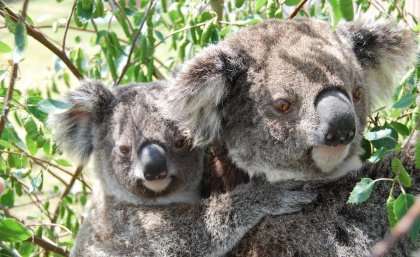Saving the little Aussie battler

Efforts to save the koala should focus on the availability of habitat and food resources under a changing climate, according to a University of Queensland researcher.
UQ Global Change Institute researcher Dr Christine Hosking has found that areas where koalas are likely to exist will shift considerably, mostly eastwards towards coastal regions where clashes with development, traffic and domestic animals pose a threat.
Dr Hosking said climate change was causing a double whammy for koalas, affecting the animals themselves, as they aren't able to cope with extreme temperatures, and also reducing the number of food trees.
"There are more than 800 species of eucalyptus in Australia, but koalas are very selective and only use a small number of those for food and moisture," she said.
"The geographic range of food tree species that are favourable to koalas is shifting and decreasing owing to the increasing severity and frequency of heatwaves and drought."
The study demonstrated that conservation efforts should include areas in which suitable habitat and food trees might thrive under a changing climate, and these areas should be protected or rehabilitated with suitable tree species.
Dr Hosking's research indicates the top-ranked priority areas for conservation across eastern states, based on predictions of where both koalas and suitable vegetation will be most likely to persist.
Queensland should focus koala conservation efforts generally within about 150km of the coast, such as the Gold Coast and Sunshine Coast hinterlands.
In NSW the focus should be on areas within about 150km of the coast, such as the Richmond Range National Park.
In Victoria the focus should be north east of Melbourne.
According to Queensland Parliamentary Papers from 1928, more than 500,000 koalas were killed in just one month during Australia's fur trade final open hunting season.
Research published in the Australian journal of Ecology suggest that koala populations crashed by up to 80 per cent due to drought and heatwaves in the Mulgalands area in the 1980's.
More recently, around Brisbane's Koala Coast in south-eastern Queensland, there has been a 51 per cent drop in koala numbers in less than three years due to urban development, according to a 2009 Queensland Government report.
Koalas are listed as vulnerable throughout Queensland, NSW and the ACT under the Environmental Protection and Biodiversity Conservation Act 1999.
"If we are to safeguard this national icon from further decline we must identify priority conservation areas where koalas are most likely to persist and where there is likely to be suitable habitat under a changing climate," Dr Hosking said.
"This is a vital koala conservation planning step that should be used to inform future policy and development decisions."
Journal information: Ecology
Provided by University of Queensland


















